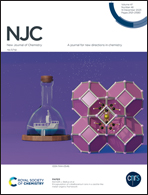Preparation of a metal phosphide derived from the dual-ligand NiFe-MOF and its boosted activity toward the electrolysis of water†
Abstract
Transition metal phosphides (TMPs) with an adjustable structure can greatly promote the activity of water electrolysis owing to the zero-valence metal property of P. Therefore, designing the structure of metal phosphides by regulating the structure of the metal–organic framework (MOF) precursor is an important method to optimize the performance of catalysts. Herein, we prepared a P-doped FeNi compound by utilizing a low-temperature phosphating bimetallic organic framework, which was grown on an NiFe foam (NFF) using terephthalic acid and 2-methylimidazole as ligands through a hydrothermal method. Compared to monometallic phosphides, bimetallic phosphides have shown excellent electrocatalytic performance. The overpotential of P-FeNi@NFF was only 194 mV for the oxygen evolution reaction at a current density of 10 mA cm−2. In addition, the overall water splitting (OWS) performance of P-FeNi@NFF was analyzed. A current density of 10 mA cm−2 could be achieved with a cell voltage of 1.59 V, and the OWS process could continue for at least 27 h at a high current density of 500 mA cm−2. Its excellent catalytic performance was mainly attributed to the excellent conductivity of the phosphide catalyst on the conductive substrate. Additionally, the lattice distortion resulting from a lattice mismatch between Ni2P and Fe2P could accelerate electron transfer, thus greatly improving the intrinsic activity of the catalyst.



 Please wait while we load your content...
Please wait while we load your content...